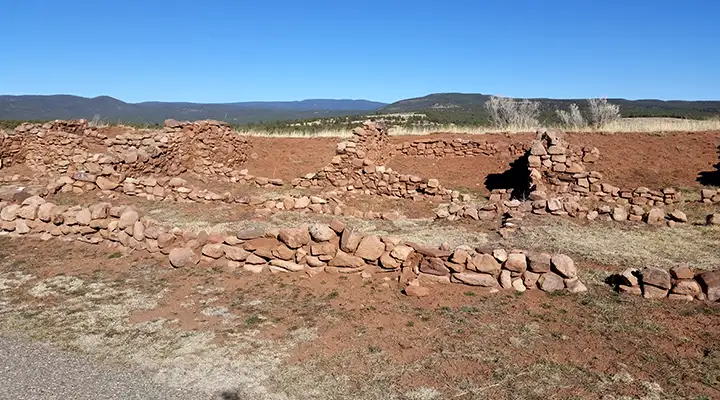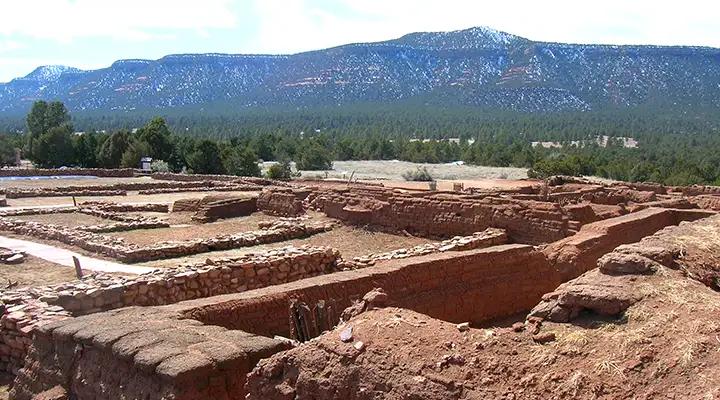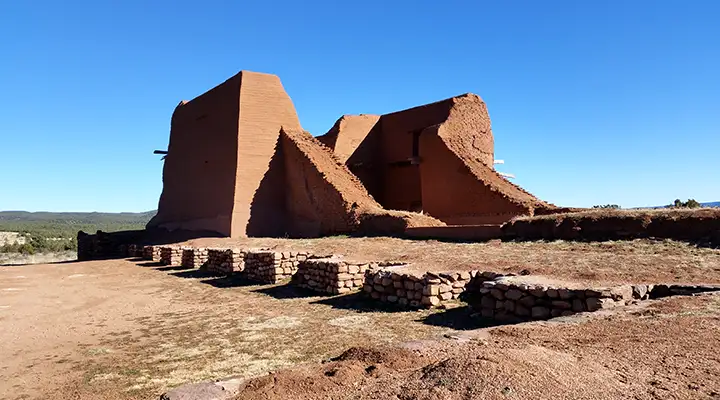Cicuyé

An excavated part of the ancient pueblo of Cicuyé
Located at the midpoint in a natural passage through the southern Sangre de Cristo Mountains, Cicuyé was an economic power for centuries, dominating trade between the Rio Grande Pueblos to the west and the Plains Indians to the east. Due to those trade connections with tribes from the Plains, Cicuyé Pueblo became one of the largest and most prosperous settlements in the Puebloan world, rivaled only by Picuris Pueblo to the north.
Describing Cicuyé in 1584, a Spanish conquistador wrote that it was on a "high and narrow hill, enclosed on both sides by two streams and many trees. The hill itself is cleared of trees... It has the greatest and best buildings of these provinces and is most thickly settled... They possess quantities of maize, cotton, beans, and squash. [The pueblo] is enclosed and protected by a wall and large houses, and by tiers of walkways which look out on the countryside. On these they keep their offensive and defensive arms: bows, arrows, shields, spears, and war clubs."
The people of Cicuyé had obviously learned that the Plains Indians they sometimes traded with could be unpredictable at times. The neighboring pueblos also viewed Cicuyé as a dominant political, economic and military force in their world. The Spaniards soon learned that Cicuyé could be a powerful ally, or a determined enemy.
About 800 CE, the first inhabitants in the area were hunter-gatherers who lived in pit houses along the drainages. It was around 1100 that the first rock-and-mud villages began to appear. About two dozen of these villages were built in the vicinity before things changed radically in the 1300s. Within one generation, most of the outlying villages were abandoned with everyone moving into the defensible position where the remains of Cicuyé still stand. The time period is concurrent with the arrival in the area of the nomadic and marauding Athabaskans who became the Apaches, Diné and Comanches. By 1450 CE, Cicuyé had grown into a 5-story, well-planned frontier fortress housing between 2,000 and 2,500 people.
Trade routes extended outwards from Cicuyé for hundreds of miles, some reaching as far as central Mexico. There was regular trade with the Paquimé and Casas Grande region until about 1450 CE. Then they were almost completely cut off from the south when the Mogollon people melted away and abandoned their cities. When Kidder excavated at Cicuyé, he found the bones of macaws and of white-fronted parrots, a species that doesn't occur naturally north of southern Sonora and Sinaloa. Remains of white-fronted parrots have also been found at Paquimé and at Grasshopper Ruin, a Sinagua pueblo in northeastern Arizona.
Kidder speculated that the people of Cicuyé spoke Towa but some others feel more like the pueblo was a mix of Tano, Tewa and Towa. The Tano came from the indigenous people in the area before the migrations of the 1100s and 1200s. The Tewa most likely would have come with migrants from the Four Corners region in the late 1200s. The Towa would have come with migrants who originated in the Fremont countryside of central Utah and passed across the Four Corners region in the late 1200s. Many of the artifacts that Kidder found in his excavation could be traced to the Pacific Coast and to the jungles of Mexico, testament to the trade routes that passed through Cicuyé. There has also been turquoise found in central Mexico that traced back to sources close to Cicuyé.
The people of Cicuyé were excellent farmers, growing abundant crops in the topsoils collected by check dams they built in the drainages to slow the rain and snow runoff. When Francisco Vasquez de Coronado came through with his men in 1541, he estimated that the pueblo's storerooms held a three-year supply of corn alone. He stole most of it and his stock destroyed the next year's crop, too.

These house foundations are outside the main pueblo construction and were discovered underneath the pueblo's huge trash pile

Remains of the rock-and-mud village that was here before the pueblo itself was built
In 1536, Cabeza de Vaca stumbled his way back into Mexico after being shipwrecked and wandering all over New Spain's northern frontier. He told stories of tantalizing legends and rich cities further north: the famous "Seven Cities of Cibola."
In 1540, Francisco Vasquez de Coronado led an army of 1,200 men, a flock of Franciscan missionaries and hundreds of stock animals northward out of Mexico in search of those legendary treasures. Six months into the journey across inhospitable terrain, he came to "Cibola" (a cluster of Zuni pueblos near present-day Gallup).
From the roof of their pueblo, the Zunis saw the Spanish dust coming from far off. It was a time of religious ceremony so they went out and lay down a trail of cornmeal across the path to their village. Then they pulled up all the ladders needed to get at them from the ground.
When Coronado came to the wall, there was no way in. He was insulted, too, that no one came out to greet him. So he had a ladder brought up and started to climb it himself. The Zunis responded by dropping large rocks over the wall and knocking him down. Several of his men jumped on top of him to protect him from further damage while they ordered their soldiers to attack.
After a fierce battle, his troops took Háwikuh, the principal Zuni village. They then raided the Zuni food stores for Coronado's famished soldiers.
Once their bellies were full, the Spaniards were only interested in finding easy gold to plunder. The Zunis had none. Coronado somehow communicated what he was looking for to the Zuni chieftains and they told him to go east. The elders even sent a man from Cicuyé to travel with Coronado and make introductions along the way.
Coronado's next stop was at the pueblo of Kuaua, about 70 miles east of Hawikuh. He and his men decided to camp out for a few days, then decided to stay the winter. That added strain on local resources led to the Tiguex War during which the Spanish looted several Tiwa pueblos in the Rio Grande Valley. In the spring Coronado and his men finally headed east.
Another 75 miles from Kuaua and he came to Cicuyé. The reception at Cicuyé was much more to his liking and he and his men camped out for a while. While they were there, the gray-clad Franciscans went around planting crosses for their strange god and "preaching" their abomination of a religion (remember: these monks were emissaries of the Spanish Inquest which was still in the depths of torturous depravity in Europe).
Then the elders of Cicuyé introduced Coronado to a captive Plains Indian. This captive told stories of Quivira, a rich land far to the east. In the spring of 1541, Coronado sent some of his men east with this Plains Indian as a guide. After wandering far into Kansas and finding only a few poor villages, the guide confessed that he'd led the Spaniards onto the Plains to die. They strangled him and then headed back west. Coronado's weakened and broken army spent another bleak winter fighting for food in the Rio Grande Valley before making their way back to Mexico empty-handed. They were harassed by Puebloans and other tribes nearly the entire way back.
In 1581, silver prospectors from northern Mexico again made their way into the Pueblo territories. They also found neither mineral riches nor golden cities. But they did find that the land of the Puebloans could support livestock and farming. That changed everything.
Don Juan de Oñate made the journey north in 1598 with settlers, livestock and 10 Franciscans to occupy and claim the territory for the King of Spain. He almost immediately assigned a friar to Cicuyé who started things off very badly with his religious bigotry and idol-smashing.
In 1621, the Franciscans sent Fray Andrés Juarez to Cicuyé as a healer and builder. His relationship with the people of the pueblo was much better. Under his direction, the Puebloans built the most imposing mission church in all of Nuevo Mexico, with towers, buttresses and huge pine-log beams.

Pens built to house the priests' stock animals

Foundations of what was the first floor of the multi-storied pueblo
This was also during the same time that church and civic leaders were vying with each other for the Indians' labor, tribute and loyalties. What the Puebloans experienced of this was an ever-growing economic hardship and religious repression. The decades of Spanish demands and Indian resentments climaxed in the Pueblo Revolt of 1680. At Cicuyé, the local priest was warned but he didn't leave. He was soon killed by the tribe and the church was almost completely destroyed. Within a few weeks the Spanish had been expelled from virtually all of Nuevo Mexico.
Don Diego de Vargas returned at the head of his army in 1692. He expected to have a fight on his hands at Cicuyé but found their opinion had shifted. The people welcomed him and actually supplied 140 warriors to help him retake Santa Fe.
This time around, the Franciscans moderated their religious zeal and abolished all tribute. In return, the Cicuyés became partners in a slightly more relaxed Spanish-Pueblo community and rebuilt the mission church at Cicuyé, although the new church wasn't as imposing (or as costly in labor) as the previous one was. However, by the 1780s, disease, migration and Comanche raids had reduced the population of Cicuyé to less than 300.
When Santa Fe Trail trade began flowing through the valley in 1821, Cicuyé was almost a ghost town. The last survivors left the empty mission church and decaying pueblo in 1838, moving to join Towa-speaking relatives at Jemez Pueblo, 80 miles to the west. Many travelers along this part of the Santa Fe Trail camped nearby to visit the ruins of Cicuyé, and romanticize about the "ancients" who'd left this remarkable construction behind.

The mission ruin itself
Sites of the Ancients and approximate dates of occupation:
Atsinna : 1275-1350
Awat'ovi : 1200-1701
Aztec : 1100-1275
Bandelier : 1200-1500
Betatakin : 1275-1300
Casa Malpais : 1260-1420
Chaco Canyon : 850-1145
Fourmile Ranch : 1276-1450
Giusewa : 1560-1680
Hawikuh : 1400-1680
Homol'ovi : 1100-1400
Hovenweep : 50-1350
Jeddito : 800-1700
Kawaika'a : 1375-1580
Kuaua : 325-1580
Mesa Verde : 600-1275
Montezuma Castle : 1200-1400
Payupki : 1680-1745
Poshuouingeh : 1375-1500
Pottery Mound : 1320-1550
Puyé : 1200-1580
Snaketown : 300 BCE-1050
Tonto Basin : 700-1450
Tuzigoot : 1125-1400
Wupatki/Wukoki : 500-1225
Wupatupqa : 1100-1250
Yucca House : 1100-1275